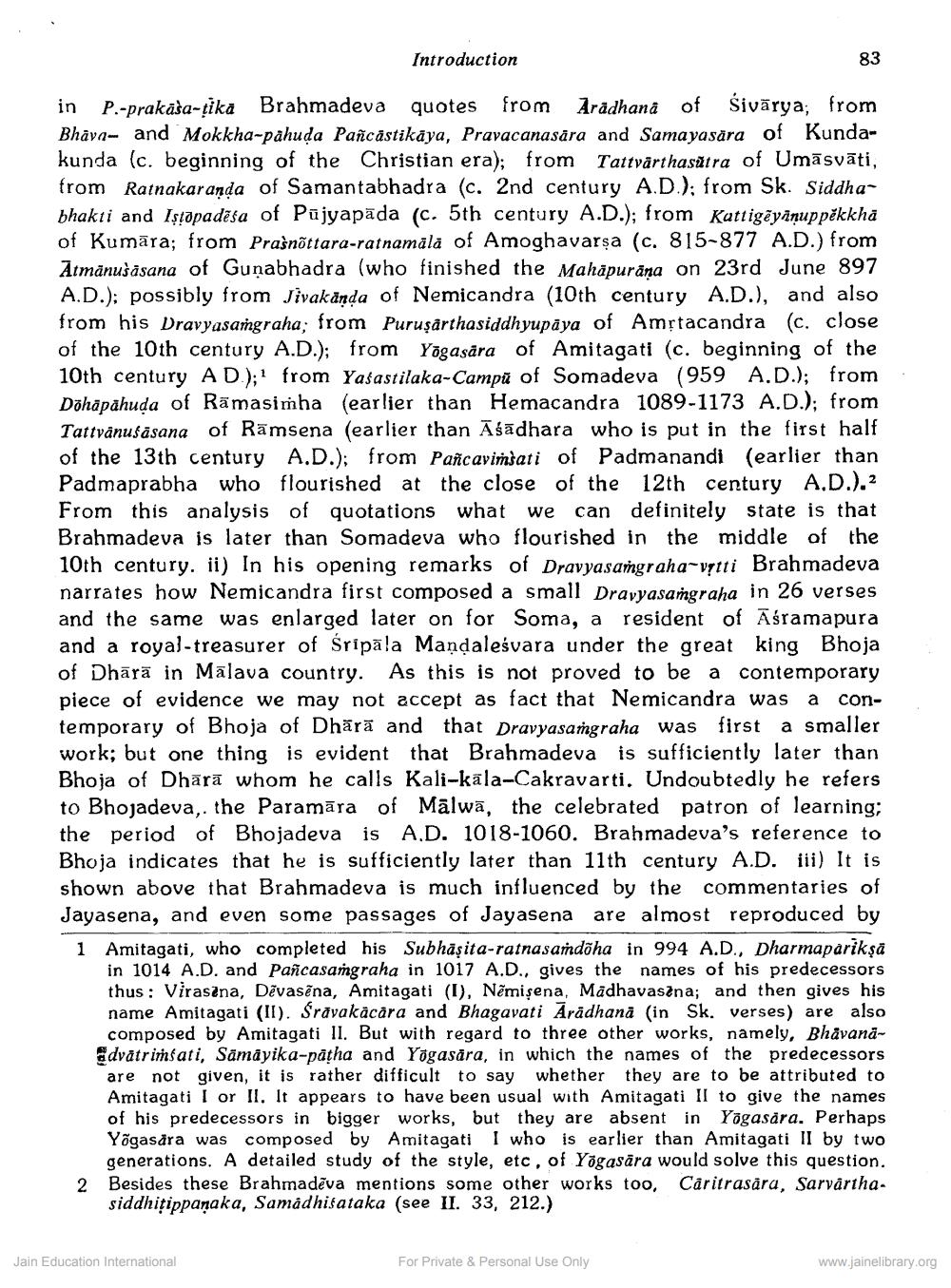________________
Introduction
83
in P.-prakasa-tika Brahmadeva quotes from Aradhana of Sivärya; from Bhava- and Mokkha-pähuda Pañcâstikaya, Pravacanasāra and Samayasära of Kundakunda (c. beginning of the Christian era); from Tattvärthasätra of Umāsvāti, from Ratnakaranda of Samantabhadra (c. 2nd century AD.); from Sk. Siddhabhakti and Istopadēsa of Pujyapada (c. 5th century A.D.); from Kattigēyānuppěkkha of Kumāra; from Praènõttara-ratnamála of Amoghavarşa (c. 815-877 A.D.) from Atmānušāsana of Guņabhadra (who finished the Mahāpuräna on 23rd June 897 A.D.); possibly from Jivakanda of Nemicandra (10th century A.D.), and also from his Dravyasamgraha; from Puruşarthasiddhyupaya of Amrtacandra (c. close of the 10th century A.D.); from Yogasära of Amitagati (c. beginning of the 10th century AD.);1 from Yašastilaka-Campū of Somadeva (959 A.D.); from Döhāpähuda of Rämasimha (earlier than Hemacandra 1089-1173 A.D.); from Tattvanusāsana of Ramsena (earlier than Āsādhara who is put in the first half of the 13th century A.D.); from Pancavimšati of Padmanandi (earlier than Padmaprabha who flourished at the close of the 12th century A.D.).2 From this analysis of quotations what we can definitely state is that Brahmadeva is later than Somadeva who flourished in the middle of the 10th century. ii) In his opening remarks of Dravyasangraha-vịtti Brahmadeva narrates how Nemicandra first composed a small Dravyasangraha in 26 verses and the same was enlarged later on for Soma, a resident of Aśramapura and a royal-treasurer of Sripala Mandalesvara under the great king Bhoja of Dhārā in Malava country. As this is not proved to be a contemporary piece of evidence we may not accept as fact that Nemicandra was a contemporary of Bhoja of Dhārā and that Dravyasaņgraha was first a smaller work; but one thing is evident that Brahmadeva is sufficiently later than Bhoja of Dhārā whom he calls Kali-kala-Cakravarti. Undoubtedly he refers to Bhojadeva,. the Paramāra of Malwā, the celebrated patron of learning; the period of Bhojadeva is A.D. 1018-1060. Brahmadeva's reference to Bhoja indicates that he is sufficiently later than 11th century A.D. iii) It is shown above that Brahmadeva is much influenced by the commentaries of Jayasena, and even some passages of Jayasena are almost reproduced by 1 Amitagati, who completed his Subhāṣita-ratnasamdõha in 994 A.D., Dharmapariksa
in 1014 A.D. and Pancasangraha in 1017 A.D., gives the names of his predecessors thus: Virasina, Dīvasēna, Amitagati (I), Nēmisena, Madhavasına; and then gives his name Amitagati (II). Śrāvakācāra and Bhagavati Aradhana (in Sk. verses) are also composed by Amitagati II. But with regard to three other works, namely, Bhavanaadvätrimati, Sāmāyika-patha and Yogasära, in which the names of the predecessors are not given, it is rather difficult to say whether they are to be attributed to Amitagati I or Il. It appears to have been usual with Amitagati II to give the names of his predecessors in bigger works, but they are absent in Yogasära. Perhaps Yõgasära was composed by Amitagati 1 who is earlier than Amitagati II by two
generations. A detailed study of the style, etc, of Yogasāra would solve this question. 2 Besides these Brahmadēva mentions some other works too, Caritrasara, Sarvartha.
siddhitippanaka, Samadhisataka (see II. 33, 212.)
Jain Education International
For Private & Personal Use Only
www.jainelibrary.org




